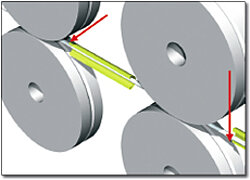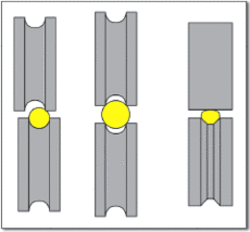MIG welding
Wire scratching at metallic edges
It must be guaranteed that the wire does not scratch over hard or metallic edges during its way from the spool to the contact tip and gets damaged thereby. Critical points are shown in the following drawings. Guiding tubes and inlet nozzles close to the feeding rolls are frequently not properly adjusted, have a too small diameter or have a bur. The same is true with contact tips which are not suitable for soft wires in many cases. The bore diameter of contact tips forAluminium must be larger by approximately 0.2 mm than for steel. Contact tips for steel have a bore diameter which is usually 0.15-0.2 mm larger than the wire diameter, which means that tips for Aluminium need to be 0.35-0.4 mm in diameter than the wire itself.
Unsuitable wire-feed-rolls
Rolls for Aluminium and Copper wires must be specially designed for Aluminium by its manufacturer. A so-called semi-round groove or a similar groove shape is common. The picture shows frequent mistakes in connection with wire-feed rolls. The pressure force of the rolls to each other must be as low as possible. It must not be increased when sudden wire-feed problems occur, but the reason for the problems needs to be investigated and removed.
Humidity and porous gas hoses
It is commonly found that the reason for porosity caused by Hydrogen can be traced to the state of the gas hoses. It can happen that gas- and water hoses get mixed up and water gets into the gas hoses. In general these hoses should be changed completely after such an incident, because a full dry-out is not possible. Another reason for humidity is caused by porous or leaking hose materials.
According to Fick`s law even seemingly dense materials are diffusible to matter (gases) if the partial pressure of the component is lower inside than outside. Humidity in the atmosphere diffuses through a hose wall if dry shielding gas is inside. Counter measurements are a low permeability of the hose material, short hoses and a greater wall thickness.
Contamination
The wire-feed systems and especially all parts that come in touch with the wire need to be kept as clean as possible. Usage of lubricants and anti-spatter spray must be avoided. The wire spools need to be covered at any time and protected from dust and humidity.
Friction in the wire-feed system
Aluminium has poor gliding characteristics in general. Even though it needs to be fed through several meters of liner. The liner material must be paid special attention to. With opened clamping levers of the wire-feed rolls it must be possible to push the wire with two fi ngers and medium force through the entire wire feed system. A good source of information is provided by modern power-sources which measure the current into the wire-feed motor. This should be close to the idle value and be observed frequently.
Arc too long
Adjusting a long arc often leads to the absorption of large quantities of atmosphere into the arc. This results in porosity and oxide inclusions. Thus, the welding parameters need to be optimised for an arc as-short-as possible. This requires much experience and sometimes demands assistance from the manufacturer of the power source.
TIG welding
With TIG welding additional care has to be taken that already opened boxes of rods must be kept closed and be protected against dust and humidity. For instance it is recommended to remove as many rods as needed for the next few hours. Directly before welding the rod can be cleaned with fi ne steel wool. The rod must not be held with bare hands and the gloves need to be clean and free of grease. Attention has to be given that the end of the rod remains within the shielding gas until it is suffi ciently cooled to prevent unnecessary oxidation. The above mentioned rules concerning humidity and leaky gas hoses are the same for TIG welding.









